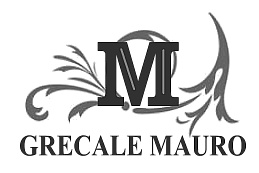

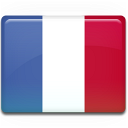
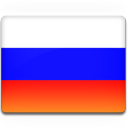
Biografia
Alla domanda se artisti si nasca o si diventi, Mauro Grecale sembra soddisfare la seconda ipotesi; si avvicina infatti alla creatività non attraverso folgorazioni o esplosioni di talento, ma a poco a poco, partendo da una sana attività artigianale. Grecale viene da una famiglia di artigiani del legno, ha dunque fin da subito grande familiarità con un mondo che ruota intorno all’arte, ne fa da corollario, da complemento.
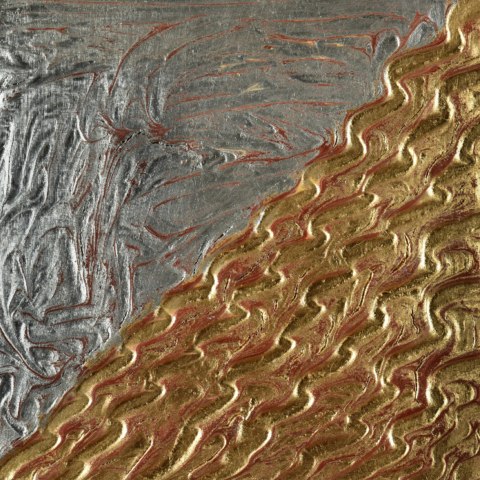
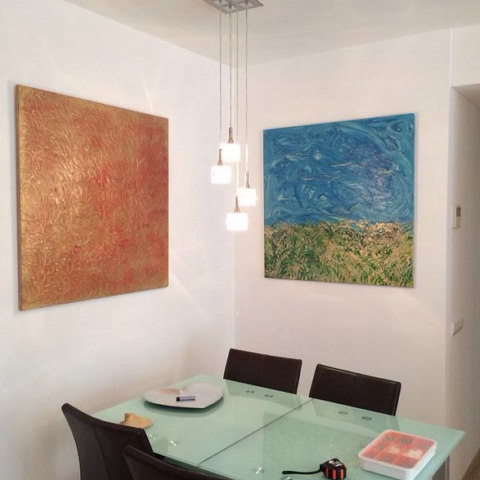
Sembra quasi inevitabile che chi cresce in questo mondo non sia tentato, una volta o l’altra, di misurarsi con i colori, lo spazio di una tela: anche solo per gioco! Il materiale che gli è più congeniale, tra i tanti maneggiati, è il gesso; con il gesso tenta i primi esperimenti, un gioco appunto, che piano piano lo coinvolge con sempre maggiore entusiasmo ed energia.
Inizia cospargendo di gesso non levigato delle tavolette di legno e dipingendo questa superficie ruvida con immagini semplici, il sole, la luna, un paesaggio, un campo di grano; passa da piccolissimi formati a grandi dimensioni, apparendo, a chi guarda questi primi lavori, un buon dilettante animato da tanto entusiasmo e buona volontà.
Si libera a poco a poco dei riferimenti; un pò troppo facili e retorici, alla realtà paesaggistica e, mantenendo ancora le sue basi di gesso, tenta la strada dell’astrazione; le forme svaniscono e lasciano spazio ad un gioco di colori forti, accentuati dalla rugosità del supporto; è il primo salto di qualità.
Insomma, Grecale fa sul serio e costringe anche chi guarda queste opere a vederle in una prospettiva meno amatoriale, a leggerle secondo un sistema non più solamente riconducibile al gioco decorativo, ma a ridefinirle nell’ambito di un linguaggio espressivo.
Potrebbe bastare, ma Grecale non si ferma, va oltre, ed approda agli ultimi lavori i quali rivelano una ormai trovata maturità nell’aver individuato una precisa cifra stilistica; si parte ancora da una tavola di legno cosparsa di gesso, lasciato solitamente del suo colore biancastro, un simbolo di terra argillosa, arida: in questa superficie si aprono delle spaccature che mostrano una superficie sottostante, liscia, levigata, decorata con giochi cromatici morbidi, dai colori tenui ottenuta, supponiamo, con stratificazioni di smalti.
Il percorso sembra dunque compiuto!
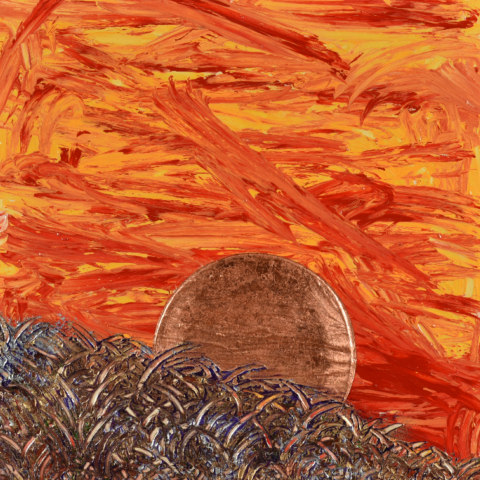
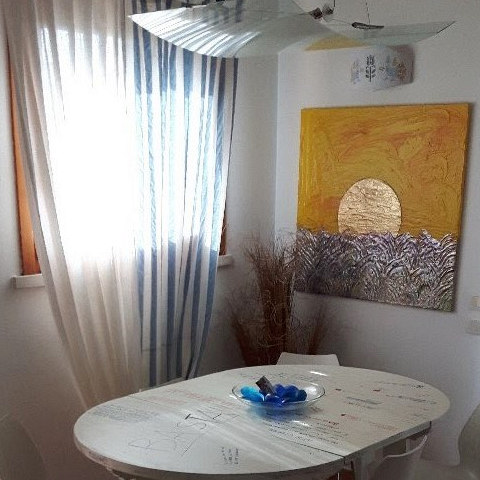
Biography


The son of a family of woodworking artisans, Grecale immediately and intimately became acquainted with a world revolving around art, which developed into an addition and a complement to his life.
It seems almost inevitable that people who grow up in such a world are tempted, at one time or another, to try their hand at putting colours on a canvas…if only for play! Out of the many materials Grecale has handled, he feels most in harmony with plaster. His first experiments were in plaster and were executed just for play.
But little by little, they took up more and more of his enthusiasm and energy.
He began with unfinished plaster spread on wood panels and painted these rough surfaces with simple images…the sun, the moon, a landscape, a field of grain.
He then went from very small to very large formats. An examination of these early works suggests a talented amateur with great enthusiasm and eagerness.
Slowly but surely, he phased out his overly simple, rhetorical references to landscapes and embraced abstract expression, while keeping plaster as the base medium. The shapes gave way to an interplay of strong colours accentuated by the roughness of the support. It was his first breakthrough.
In short, Grecale was in earnest. He forced the viewer to see his works as less the efforts of a dilettante and to interpret them as no longer attributable to decorative play, but redefined as part of an expressive language.
Grecale could have stopped there; instead, he has outdone his previous efforts in his latest works, which show an established maturity in his development of a specific stylistic code.
He again starts with a wood panel spread with plaster, which is usually left in its original whitish colour as a symbol of the arid, clayey earth. Open fractures on this surface reveal a smooth, sandpapered, underlying plane decorated with a soft interplay of pale colours, presumably obtained with multiple layers of enamel. Grecale’s artistic quest thus seems to come to an end! After his first uncertain efforts, Grecale – in only a short time – has accomplished works that fully illustrate his artistic exploration and its successful conclusion.


Biographie
A la demande:nait-on artiste peintre ou le deviènt-on? Mauro Grecale répond:on le devient. En effet il commence à créer,non par une explosion soudaine de talent mais peu à peu,en partant d’une saine activité artisanale.
Grecale fait partie d’une famille d’artisans du bois;il a donc tout de suite une certaine familiarité avec un monde qui tourne autour de cet art. il semble inévitable que les personnes qui vivent dans ce monde soient tentées,une fois ou l’autre,de se mesurer avec les couleurs et l’espace d’une toile,même si c’est par jeu.
La matière qu’il préfère parmi toutes celles qu’il a utilisées c’est le plâtre. Il tente alors ses premières expériences;un jeu presque qu’il continuera peu à peu avec enthousiasme et énergie.


Il commence à parsemer de plâtre des tablettes de bois et à peindre ces surfaces d’images très simples:le soleil,la lune,un paysage,un champ de blè. Il passe du petit format à de plus grandes dimensions.
Par ceux qui regardent ses premières peintures Grecale est considéré comme un bon amateur,animé d’un grand enthousiasme et d’une bonne volonté. Peu à peu il se libère des références tróp faciles et de la réalitè paysagiste.
Même s’il utilise encore des bases de plâtre il tente la route de l’abstráit;les formes s’estompent et laissent la place à un jeu de couleurs fortés et encore plus marquées par le relief de la base;il s’agit du premier saut de qualité.
Grecale se corse.Il oblige les personnes qui regardent ses peintures à les voir d’une façon différente; il faut les lire non seulement comme un jeu de dècoration mais comme un langage espressif. Cela pourrait suffire mais Grecale ne s’arrète pas;il continue sa route et va plus loin.
Des timides premières toiles il est arrivé,en un temps assez bref à des tableaux qui mettent en évidence une maturité certaine et un style bien précis. Heureuse conclusion de toute sa recherche et de la passion mise dans son travail.
Grecale est né dans la banlieu de Milan en 1961. C’est là qu’il vit et travaille. Il a participé à de nombreuses expositions avec grand succès.


Мауро ГРЕКАЛЕ


Среди всех используемых материалов более всего по вкусу ему пришелся гипс. Используя именно гипс, по сути играясь, он начинает эспериментировать, но постепенно увлекается все с большим энтузиазмом и энергией.
Он начинает размещать неровным слоем гипс на девевянной досточке и расписывать эту поверхность такими незатейливыми изображениями, как солнце, луна, поле, пейзажи. Затем от малых форматов переходит к большим. Первым, кто видит его работы он кажется простым дилетантом, полным энтузиазма и добрых намерений. Постепенно освобождаясь от банальных и риторических сюжетов, пейзажистики, сохраняя гипсовую основу, он пробует ступить на путь абстрактного искусства. Исчезают конкретные формы, оставляя пространство игре цветов, подчеркнутых неровностью основы, таким образом осуществляется переход на новый качественный уровень.
Грекале всерьез заявляет о себе, заставляя зрителей рассматривать его творения менее дилетансткими, не только декоративными, но и обладающими собственным выразительным языком. Уже этого могло бы быть достаточно, но Грекале не останавливается и идет дальше. В его последних работах ярко проступает обретенная зрелость, подтверждающая нахождение собственного стилистического почерка.
Начинает все с той доски с нанесенным гипсом, который теперь оставляется натурального беловатого цвета, символизирующего потрескавшуюся от жажды глинистую почву. Но сквозь трещины гипса проступает гладкая, хорошо обработанная цветная поверхность с мягкой хроматической игрой нежных тонов, полученных, по-видимому, наложением нескольких слоев эмали. Таким образом цель, похоже, достигнута!


